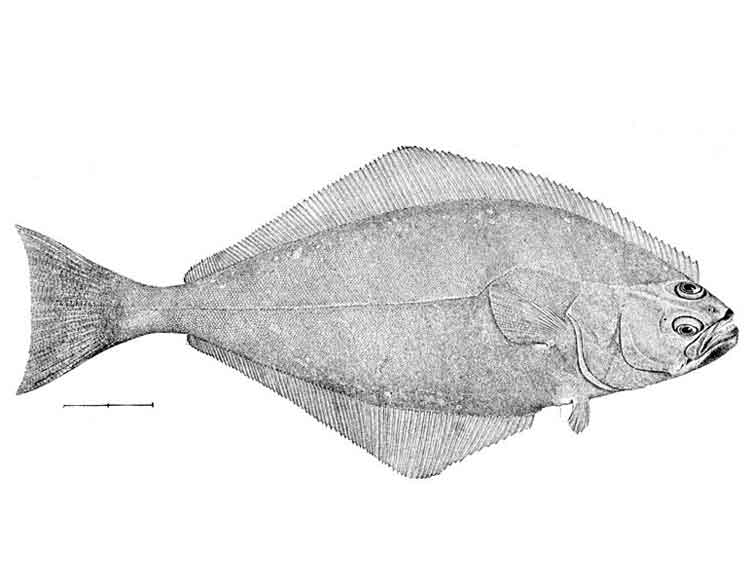Hippoglossus hippoglossus Cladus: Eukaryota Name Hippoglossus hippoglossus (Linnaeus, 1758) References * Hippoglossus hippoglossus Report on ITIS
The Atlantic halibut, Hippoglossus hippoglossus, is a flatfish of the family Pleuronectidae. They are demersal fish, that live on or near sand, gravel or clay bottoms at depths of between 50 and 2,000 metres (160 and 6,600 ft). The halibut is among the largest teleost (bony) fish in the world. Halibut are strong swimmers and are able to migrate long distances. Halibut size is not age-specific, but rather tends to follow a cycle related to halibut (and therefore food) abundance. The native habitat of the Atlantic halibut is the temperate waters of the northern Atlantic, from Labrador and Greenland to Iceland, the Barents Sea and as far south as the Bay of Biscay. It is the largest flatfish in the Atlantic and one of the largest species of flatfish in the world, reaching lengths of up to 4.7 metres (15 ft) and weights of 320 kilograms (710 lb). Its lifespan can reach 50 years.[1][2]
The Atlantic halibut is a right-eyed flounder. It is flattened sideways and habitually lies on the left side of its body with both eyes migrating to the right side of its head during development. Its upper surface is a uniformly dark chocolate, olive or slate colour, and can be almost black (though younger fish are lighter and more mottled); the underside is pale. The end of the caudal fin is concave.[2] Young fish are paler with more mottled colouration.[3] Biology The Atlantic halibut has a relatively slow growth rate and late onset of sexual maturity, with males attaining maturity at seven to eight years old, females at ten to eleven years, and individuals are thought to live up to 50 years. Little is known about their breeding except that spawning is seasonal, although its timing varies somewhat with location. In the eastern Atlantic spawning occurs chiefly in March, April and May, although may span from January to June. Off the American coast, however, the spawning season appears to continue through the summer as late as September. After spawning both sexes migrate northwards in search of food. Young Atlantic halibut individuals feed on crustaceans like crabs and prawns. These halibut lie motionless and invisible on the sea bed, capturing any fish that pass within reach, although they may also hunt for fish in open water.[1][3] Habitat This marine fish usually lives on the ocean floor at depths of between 50 to 2000 metres, but it occasionally comes closer to the surface. The larvae are pelagic, drifting relatively helplessly, but at around four centimetres they migrate to the bottom. Young between the ages of two and four years live close to the shore, moving into deeper waters as they grow older.[1][3] Role in ecosystem The Atlantic halibut occupies a relatively high trophic level in the food chain. Diet The diet of the Atlantic halibut consists mainly of other fish, e.g. cod, haddock, herring, pogge, sand eels and capelin, but it will also eat cephalopods, large crustaceans and other benthos organisms.[1][2] Predators Atlantic halibut are eaten by seals, and are a staple food of the Greenland shark.[2] Commercial fishing The Atlantic halibut was formerly a very important food fish, but due to its slow rate of population growth it is unable to recover quickly from overfishing, and the fishery has largely collapsed. Consequently, fish labelled as "halibut" is usually one of the other large flatfishes, often Pacific halibut, Hippoglossus stenolepis. Farming Due to its popularity as a food fish, Atlantic halibut has attracted investment in fish farming. As of 2006, five countries - Canada, Norway, the UK, Iceland and Chile - were engaged in some form of Atlantic halibut aquaculture production.[4] Conservation status Following overfishing the Atlantic halibut now faces a high risk of extinction in the wild, and in 1996 the IUCN rated it as Endangered and placed it on its Red List.[5] The Atlantic halibut is a U.S. National Marine Fisheries Service Species of Concern. Species of Concern are those species about which the U.S. government’s National Oceanic and Atmospheric Administration, National Marine Fisheries Service, has some concerns regarding status and threats, but for which insufficient information is available to indicate a need to list the species under the U.S. Endangered Species Act(ESA). The American Fisheries Society has classified the species as "Vulnerable". In 2010, Greenpeace International has added the atlantic halibut to its seafood red list. "The Greenpeace International seafood red list is a list of fish that are commonly sold in supermarkets around the world, and which have a very high risk of being sourced from unsustainable fisheries."[6] External links Atlantic halibut media at ARKive References This article incorporates text from the ARKive fact-file "Atlantic halibut" under the Creative Commons Attribution-ShareAlike 3.0 Unported License and the GFDL. ^ a b c d "Hippoglossus hippoglossus". Fishbase. 5 June 2009. Retrieved 2009-06-22.
Source: Wikipedia, Wikispecies: All text is available under the terms of the GNU Free Documentation License |
|

